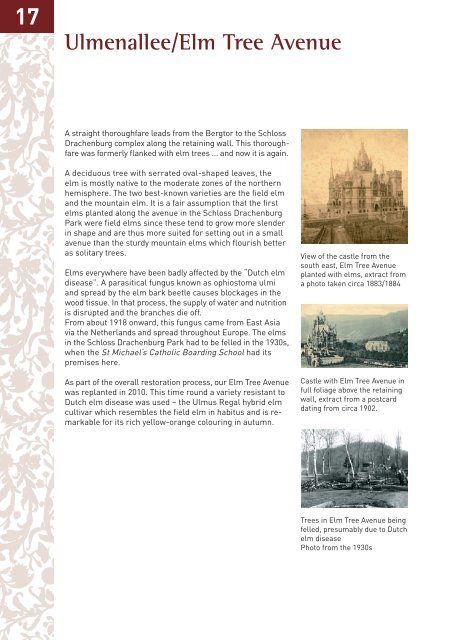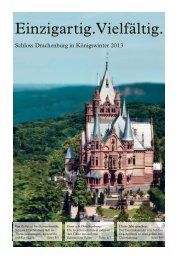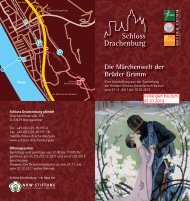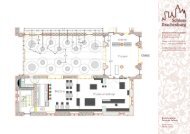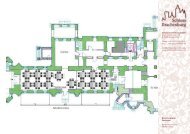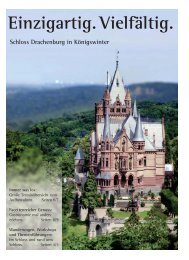North Tower - Schloss Drachenburg
North Tower - Schloss Drachenburg
North Tower - Schloss Drachenburg
You also want an ePaper? Increase the reach of your titles
YUMPU automatically turns print PDFs into web optimized ePapers that Google loves.
17<br />
Ulmenallee/Elm Tree Avenue<br />
A straight thoroughfare leads from the Bergtor to the <strong>Schloss</strong><br />
<strong>Drachenburg</strong> complex along the retaining wall. This thoroughfare<br />
was formerly fl anked with elm trees ... and now it is again.<br />
A deciduous tree with serrated oval-shaped leaves, the<br />
elm is mostly native to the moderate zones of the northern<br />
hemisphere. The two best-known varieties are the fi eld elm<br />
and the mountain elm. It is a fair assumption that the fi rst<br />
elms planted along the avenue in the <strong>Schloss</strong> <strong>Drachenburg</strong><br />
Park were fi eld elms since these tend to grow more slender<br />
in shape and are thus more suited for setting out in a small<br />
avenue than the sturdy mountain elms which fl ourish better<br />
as solitary trees.<br />
Elms everywhere have been badly affected by the “Dutch elm<br />
disease”. A parasitical fungus known as ophiostoma ulmi<br />
and spread by the elm bark beetle causes blockages in the<br />
wood tissue. In that process, the supply of water and nutrition<br />
is disrupted and the branches die off.<br />
From about 1918 onward, this fungus came from East Asia<br />
via the Netherlands and spread throughout Europe. The elms<br />
in the <strong>Schloss</strong> <strong>Drachenburg</strong> Park had to be felled in the 1930s,<br />
when the St Michael‘s Catholic Boarding School had its<br />
premises here.<br />
As part of the overall restoration process, our Elm Tree Avenue<br />
was replanted in 2010. This time round a variety resistant to<br />
Dutch elm disease was used – the Ulmus Regal hybrid elm<br />
cultivar which resembles the fi eld elm in habitus and is remarkable<br />
for its rich yellow-orange colouring in autumn.<br />
View of the castle from the<br />
south east, Elm Tree Avenue<br />
planted with elms, extract from<br />
a photo taken circa 1883/1884<br />
Castle with Elm Tree Avenue in<br />
full foliage above the retaining<br />
wall, extract from a postcard<br />
dating from circa 1902.<br />
Trees in Elm Tree Avenue being<br />
felled, presumably due to Dutch<br />
elm disease<br />
Photo from the 1930s


